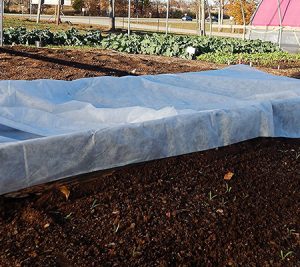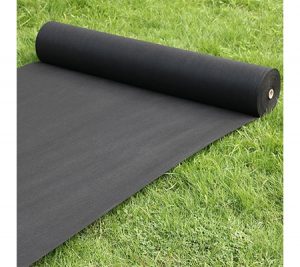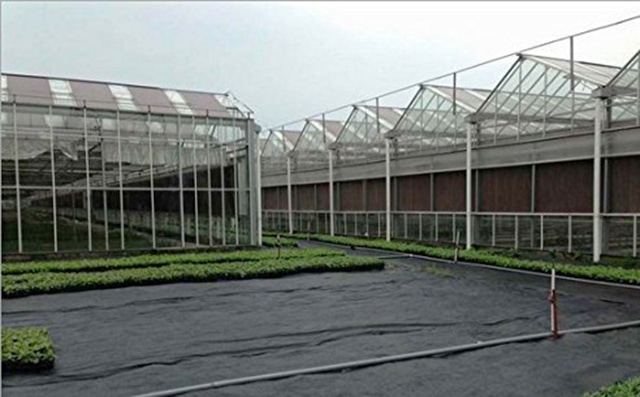How To Use Woven Ground Cover For Garden

When I hear the words garden fabric, I think landscape fabric, the black cloth underlayment used in my xeriscaping, and the material my mom used to used in the vegetable garden every year. You may not ever notice it since sometimes it is covered up with mulch.
I've discovered that the term 'garden fabric' is loosely used and has multiple meanings depending on personal experience after I recently I also heard the lightweight, white cloth used to cover rows of plants referred to as garden fabric as well. This got me thinking about the many uses of fabrics in the garden and how they can be both beneficial when used correctly, or harmful if used incorrectly.
Since we spend a lot of time in the yard and garden so we can reap the benefits, I thought it would be prudent to to define the two ways garden fabrics can be interpreted- and how each are used within your landscaping and garden to achieve your desired results.
WHAT IS GARDEN FABRIC?
To start, garden fabric is any sort of cloth or cover that can be used in a variety of ways in your yard. Durability, color, breathability, materials, and thickness all play a part in its usefulness, and so for this article I'm going to first define the different kind of fabric to better explain where, and how, it's used.

LANDSCAPE FABRIC
Landscape fabric is defined as a black, woven or non-woven cloth made from polyester, linen, or polypropylene used to help keep weeds in check, and moisture in the ground.

ROW COVERING
Row cover, or floating row cover is a lighter weight material than landscape fabric made of polypropylene, is white, and is used for tender plant protection from both heat and cold depending upon the application.
HOW TO USE LANDSCAPE FABRIC IN THE GARDEN

Best suited for perennial flower gardens and tree beds, this black fabric is laid out and secured into the ground using garden staples to discourage weeds from taking root. Also occasionally used in annual vegetable gardens to rip up at harvest, these fabrics have gained popularity through the years due to how much time is saved in clearing gardens from unwanted choking weeds or unruly plant suckers through the growing season. Plants are easily planted through the fabric by cutting a hole with a good garden knife before mulching the top to help protect the fabric from the sun.
Fabric is easily unrolled from the rolls they are sold in and cut to a personalized length. When making a larger size, simple overlap at least three inches and staple securely to keep weeds from forcing themselves between the seams. Because of this, sturdy landscaping fabrics are also a popular underlayment for xeriscaping, the achievement of a minimalist look in dry, arid regions where water is not readily available for landscaping purposes. Fabric covered in colorful rocks and mulches surround heat tolerant plants for unique looks throughout many areas in the Southern states.
*You might also like: Reclaim Your Garden Bed for Spring Planting
THINGS TO CONSIDER WHEN USING LANDSCAPE FABRIC
Not all is made equal however, and the fabric you choose for an annual vegetable garden may not be the same choice that you want for long-term use in a flower bed, or desertscape. There are a variety of product thicknesses, breathability, material, durability, and costs provided by multiple manufacturers, and when making your decision to purchases, you'll need to first and foremost consider what you will be using it for.

NON-WOVEN
Non-woven landscape fabrics may allow a bit of breathability and small amounts of water movability, but generally they are used to suffocate anything beneath it to keep the area it covers clear of vegetation. This is a popular cloth to use for xeriscaping that does not include plants and is decorated using only rocks, or other non-vegetative structures, or to provide support to soils structures. It is often also found under walkways to keep any sort of deep rooting plants from undermining the materials used, and to prevent heaving.
Keep in mind that over time dirt and debris can easily create a soil substrate on top of a non-woven fabric that plants can take root in. If the area is well maintained these weeds can be removed easily without causing damage, but if left over a long period it could compromise the use of the fabric.

WOVEN
Woven fabric is created with the movement of water in mind, and is often found as an annual ground cloth for vegetable gardens, or for areas where vegetation will be used. The woven material creates both breathability and porous openings for water to soak into the soils underneath so your plants receive the moisture and fertilizer you may provide. It also helps to keep soil moisture from evaporating: making this a helpful garden product in arid, dry climates.
To use, simply spread it out and secure it down before cutting holes in the material to plant your vegetation choices through. If using annually as a garden weed fabric you can simply take it up at the end of the year and discard, and if you are using it as a permanent underlayment, simply cover with mulch for further moisture and weed control and leave it alone.
Because this fabric is meant to hold allow moisture to move through it, and also has holes, weeds that take hold can grow through the material easily and it is imperative that you use a weed killer regularly, or be sure to pull weeds early on to keep from ripping up you fabric later down the road.

THICKNESS
Keep in mind that there are different thicknesses offered in both woven and non-woven fabrics, and how you want to use your fabric should play into your determination of which to spend your money on. Thicker materials will cost more initially, but they will last longer, and may be more difficult to tear up eventually as well. Thinner materials can more easily tear, so consider what you will be putting on top of it, and how much foot traffic it may eventually receive to get the most life out of it as possible.

ULTRAVIOLET DAMAGE
Some fabrics have UV protection added, but for a cost. And most fabrics without this costly addition are just as effective, as long as you provide your own 'UV' barrier. No reason to fret, however, spreading mulch 3 to 4 inches (or more if you want) thick is generally enough protection from the damaging sun rays that will eventually break down the materials used to create landscape fabrics.
Keep in mind that organic mulches will arrive with their own variable selection of seeds that may try and take root after moisture is applied. Be sure to either treat your mulch with a weed killer a few times a year, as mentioned above, or stay on top of the weed germination and pull them before they compromise your materials.
HOW TO USE ROW COVERING IN THE GARDEN

Row covering has a variety of beneficial uses in your garden and can do everything from extend your growing season, to providing protection from pesky insects that would make a meal of your garden. The most popular use is to drape it over hoops (either bought or homemade) to raise temperatures under it for early seed germination in the spring as a frost protection, and to provide shade in areas that receive full sunlight.
These fabrics is usually such a lightweight material that you can even use them directly over plants for protective purposes without worry of your tender plants below being crushed. They are also extremely useful in that they can not only extend your growing season by allowing you an early start in the spring as mentioned, but you can also use it again in the fall to protect those plants you have yet to harvest once threat of frost becomes a reality.
Something you will want to keep an eye on is that despite its use as a pest deterrent, you can also trap unwanted bugs beneath, so be sure to either treat your pants before covering, or watch carefully for unwanted, or destructive insects that may have become trapped after putting it to use.
THINGS TO CONSIDER WHEN USING ROW COVERING
Like landscape fabric, when you are looking for how to use cover crops fabric in the garden, you need to consider the different weights and weave choices for your particular use. Some fabrics are created specifically for shade and are much more breathable for extreme high temperature climates, whereas heavier fabrics are created for more cold weather protection in mind- despite your being able to cut it how you want for usage. Be sure to keep in mind what you want your fabric for, or if you are looking for a product that can be used for multiple purposes. A good fabric should last you at least two seasons depending on the job you need it for.

ALL-PURPOSE FABRICS
All purpose fabrics allow up to 70% of available light through to your vegetation all while providing protection from the sun, wind, and flying insects. Generally these can also protect from temperatures in the high 20's for extended periods of time as long as the day time temperatures and sun allow a warming to occur. Easy to cut with scissors, but difficult to tear, this fabric should last season after season and can be stored folded up each winter.
These are considered an all-purpose fabric because they can be layered for further protection when needed for your outdoor plants, and are fairly breathable- and can also be cut in a narrow manner to be staggered over hoops for shade in areas that need it, but still breathe and allow heated air to escape.

SUMMERWEIGHT FABRICS
These lightweight fabrics are specifically for protection against birds, insects, and airborne diseases. It can also be used as a temporary barrier against damaging sprays if you happen to be treating for weeds or grasses and are concerned about overspray when applying the treatment.
These fabrics will not block precipitation or overhead irrigation, and will allow 85% or more light through to your plants. It is important to note, however, that summerweight fabrics do not protect against frost at all, and keeps very little heat trapped underneath- so this is a poor choice for growing purposes, and should be used only with protection in mind.

GARDEN QUILT
Garden quilts, or other heavier weighted fabrics are made specifically for cold weather protection and can protect plants when temperatures dip into the low 20's, or even upper teens for a short amount of time when plants would otherwise freeze without protection. At least 60% of the available light will be able to reach your vegetation, which is plenty for both seedling growing purposes, or the completion of a crop maturity. Be sure to remove your garden quilt as the weather stays above frost consistently, or replace it with a lightweight fabric, as it traps heat very easily and can wither, or kill tender plants due to excessive heat.
In some growing zones you can even use garden quilt for greenhouse purposes and keep your crops growing well into, or even though the winter. It is a great alternative to traditional greenhouse materials, and is much more cost effective although it will have to be replaced over time as both sunlight and weather will eventually break down the fibers it is made out of through time.

SHADE NETTING
Certain garden vegetables are less than tolerant of the heat and sun than others, but short of planting in multiple areas, you will have to contend with a loss of crops once the weather hits the dog days of summer; unless you provide protection that is. Shade netting or garden shade canopy is a perfect solution for those few crops that could really use some extra protection from the sun and heat without compromising breathability of the material. Leafy greens, such as lettuce and spinach, as well as peas fall into this category – two of my favorites that I enjoy having an abundance of for as long as possible.
If you live in an area that gets extremely warm, many vegetables will not do as well when temperatures reach 95 degrees or higher, and you may want to consider using shade canopy over your entire crop. Since shade canopy allows air circulation and insect pollination, there isn't much reason not to error on the side of caution in it's use: not to mention it's very easy to erect temporary shade structures to drape the cloth over.
CONSIDER YOUR CHOICES
Hopefully this article has helped define the various uses and definitions of garden fabrics for you, and provided a short overview of the multiple ways both landscape fabric and row covering can be a benefit in your yard and garden.
Let us know below what was helpful and if you have any questions about these uses if you need clarification! If you have any great ideas you'd like to share concerning how you have used fabric in your garden, we'd love to hear from you below. And as always, please share!

How To Use Woven Ground Cover For Garden
Source: https://www.backyardboss.net/how-to-use-landscape-fabric-in-garden/
Posted by: brownsproas.blogspot.com

0 Response to "How To Use Woven Ground Cover For Garden"
Post a Comment